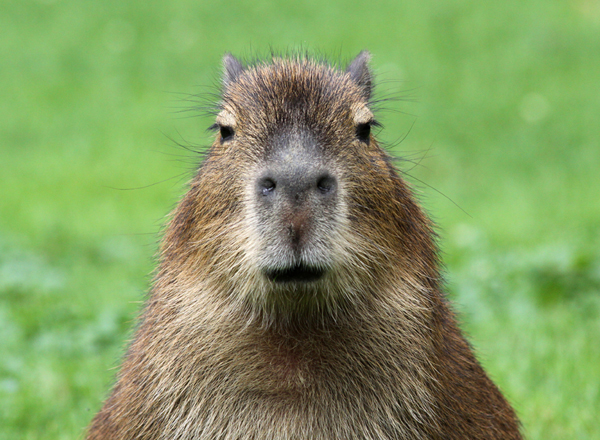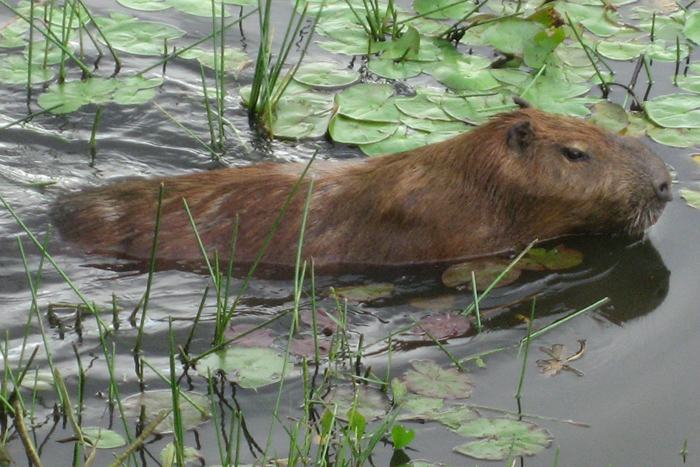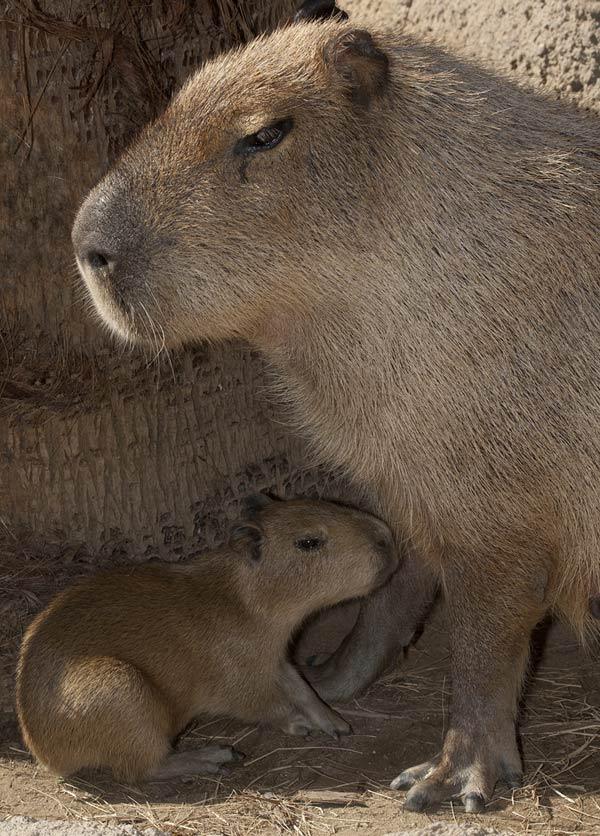Facts About Capybaras

Capybaras are the world’s largest rodent. They don’t look like the typical pests living in alleyways, though. Capybaras are as big as large dogs, have webbed feet and don’t have a tail. They don’t have the typical wedge-shaped face of most rodents, either. These rodents look much more like larger versions of their close relatives, guinea pigs.
Size
Capybaras are from about 39 to 51 inches (100 to 130 centimeters) long and about 20 inches (50 cm) tall from foot to shoulder. They tend to weigh 60 to 174 lbs. (27 to 79 kilograms), depending on gender. Females are usually a little larger than males.
Habitat
These water-loving rodents need water to keep their dry skin moist and are found only in areas with abundant water sources. Some of their moist habitats include estuaries, marshes, river banks and along streams in Central and South America, according to the International Union for Conservation of Nature (IUCN). Capybaras, also called water hogs, sleep along the water source in dense vegetation to hide from predators and to keep cool. Sometimes capybaras will nap in mud or shallow water, as well.

Habits
Capybaras are social creatures. A typical group of capybaras contains around 10 members. During the wet season, though, a group can contain around 40 members and up to 100 members during the dry season, all lead by a dominant male. A group's home range may be from five to 494 acres (two to 200 hectares), according to the San Diego Zoo.
As crepuscular animals, capybaras are most active during dawn or dusk. Sometimes, though, when capybaras feel threatened they will be nocturnal, which means they will stay awake at night and sleep during the day. The dark provides them cover while they eat and socialize so that predators are less likely to attack them.
Diet
Capybaras are herbivores and only eat vegetation. They eat mostly water plants and grasses, though grain, melons and squash can also be on the menu. Eighty percent of their diet consists of only five different species of grasses, according to the San Diego Zoo. A typical day of eating can include 6 to 8 lbs. (2.7 to 3.6 kg) of fresh grass, according to the Rainforest Alliance.
Offspring
Gestation for a female capybara can last up to 120 days. She typically gives birth to around three pups at once but can have anywhere between one to seven offspring at a time.
Pups weigh 2 to 3 lbs. (1 to 1.5 kg) at birth and already have teeth. They are weaned at 16 weeks. At 18 weeks, pups are as big as 88 lbs. (40 kg).
Around a year old, pups leave their parent’s groups to find new ones. Females sexually mature around the age of 7 to 12 months and males mature around 15 and 24 months. They typically live six to 12 years, according to the Animal Diversity Web.

Classification/Taxonomy
Here is the classification of capybaras, according to the Integrated Taxonomic Information System (ITIS):
Kingdom: Animalia Subkingdom: Bilateria Infrakingdom: Deuterostomia Phylum: Chordata Subphylum: Vertebrata Infraphylum: Gnathostomata Superclass: Tetrapoda Class: Mammalia Subclass: Theria Infraclass: Eutheria Order: Rodentia Suborder: Hystricomorpha Infraorder: Hystricognathi Family: Caviidae Subfamily: Hydrochoerinae Genus: Hydrochoerus Species: Hydrochoerus hydrochaeris
Conservation Status
Capybaras are listed as least concern by the IUCN. This is because the population seems to be large, widespread and non-threatened, though the actual population of the capybara is unknown.
Other Facts
Capybaras can stay underwater for up to five minutes at a time, according to the San Diego Zoo.
The scientific name for capybara comes from Hydro chaeris, which means "water hog" in Greek.
An Amazon tribe calls the capybara Kapiyva or "master of the grasses" in their native language.
Additional Resources
Sign up for the Live Science daily newsletter now
Get the world’s most fascinating discoveries delivered straight to your inbox.











